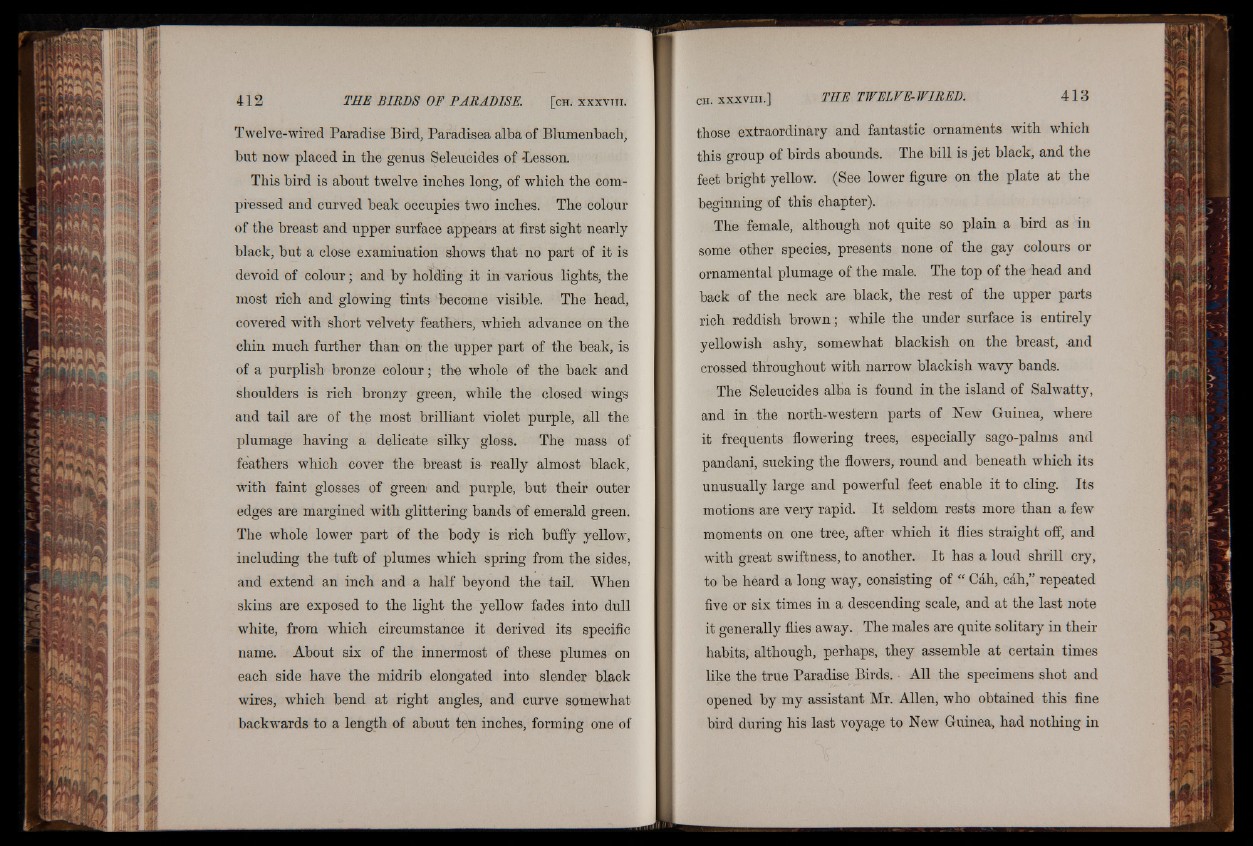
Twelve-wired Paradise Bird, Paradisea alba of Blumenbach,
but now placed in the genus Seleucides of -Lesson.
This bird is about twelve inches long, of wThich the compressed
and curved beak occupies two inches. The colour
of the breast and upper surface appears at first sight nearly
black, but a close examination shows that no part of it is
devoid of colour; and by holding it in various lights, the
most rich and glowing tints become visible. The head,
covered with short velvety feathers, which advance on the
chin much further than on the upper part of the beak, is
of a purplish bronze colour; the whole of the back and
shoulders is rich bronzy green, wrhile the closed wings
and tail are of the most brilliant violet purple, all the
plumage having a delicate silky gloss. The mass of
feathers which cover the breast is really almost black,
with faint glosses of green and purple, but their outer
edges are margined with glittering bands of emerald green.
The whole lower part of the body is rich buffy yellowy
including the tuft of plumes which spring from the sides,
and extend an inch and a half beyond the tail. When
skins are exposed to the light the yellow fades into dull
white, from which circumstance it derived its specific
name. About six of the innermost of these plumes on
each side have the midrib elongated into slender black
wires, which bend at right angles, and curve somewhat
backwards to a length of about ten inches, forming one of
those extraordinary and fantastic ornaments with which
this group of birds abounds. The bill is jet black, and the
feet bright yellow. (See lower figure on the plate at the
beginning of this chapter).
The female, although not quite so plain a bird as in
some other species, presents none of the gay colours or
ornamental plumage of the male. The top of the head and
back of the neck are black, the rest of the upper parts
rich reddish brown ; while the under surface is entirely
yellowish ashy, somewhat blackish on the breast, -and
crossed throughout with narrow blackish wavy bands.
The Seleucides alba is found in the island of Salwatty,
and in the north-western parts of New Guinea, where
it frequents flowering trees, especially sago-palms anti
pandani, sucking the flowers, round and beneath which its
unusually large and powerful feet enable it to cling. Its
motions are very rapid. It seldom rests more than a few
moments on one tree, after which it flies straight off, and
with great swiftness, to another. I t has a loud shrill cry,
to be heard a long way, consisting of “ Cah, cah,” repeated
five or six times in a descending scale, and at the last note
it generally flies away. The males are quite solitary in their
habits, although, perhaps, they assemble at certain times
like the true Paradise Birds. All the specimens shot and
opened by my assistant Mr. Allen, who obtained this fine
bird during his last voyage to New Guinea, had nothing in